2020 - the year the world had the rug pulled from under its feet. Marple endured two lockdowns between March and December, drastically reducing all cultural, social and entertainment facilities. All the cafés were closed together with the other virus casualties, Carver Theatre and the Regent Cinema.
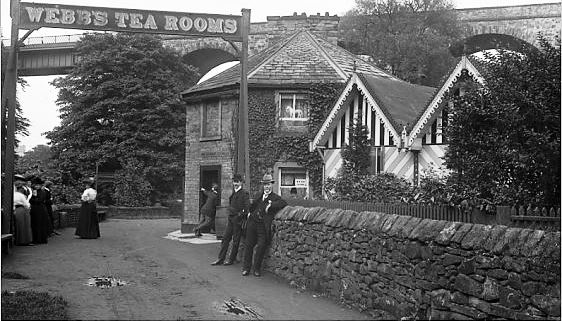
Webb's Tea Rooms (Flood Gates Cottage) © Rupert Battersby
It might seem that there is a plethora of cafés and tearooms to satisfy the local need to meet friends or to “just drop in” for an Americano or a latte or a simple cup of tea. Do we really need so many establishments to minister this need? A quick count comes to around ten and more - All Things Nice, Asda, Cloudberry, Costa, Dutsons, Golden Plate, Libbys, Red Pepper, Roc Community Café, Roman Lakes, and The Locks are all needed. There may well be more.
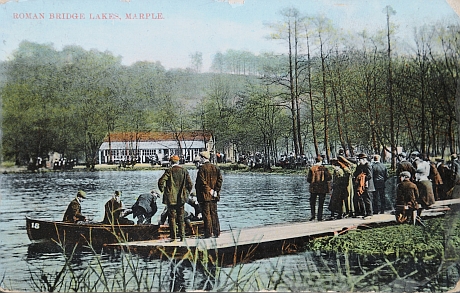 Marple’s affair with cafés probably dates from the connection to the railway network in 1865. With a majority of the workforce having but one day of a week off, this must have been of great value. The railways gave them a passport to the countryside, a breath of fresh air away from the pollution of 19th century Manchester. The area became an increasingly popular destination for works outings, Sunday School treats, and railway excursions. Pubs arranged popular attractions, tea-shops opened. Saturday and Sunday nights would see Marple Station thronged with thousands of people trying to return home to the nearby towns.
Marple’s affair with cafés probably dates from the connection to the railway network in 1865. With a majority of the workforce having but one day of a week off, this must have been of great value. The railways gave them a passport to the countryside, a breath of fresh air away from the pollution of 19th century Manchester. The area became an increasingly popular destination for works outings, Sunday School treats, and railway excursions. Pubs arranged popular attractions, tea-shops opened. Saturday and Sunday nights would see Marple Station thronged with thousands of people trying to return home to the nearby towns.
Mellor Mill had been destroyed by fire in November 1892. At Christmas 1892, Edwin Furness, who had been manager of the mill, sat in his home at Strawberry Hill, with his brother. The decision was made to open up the mill ponds as the tourist destination, Roman Lakes, to generate income, Edwin having lost his livelihood. Though is likely that commercial cafés existed from sometime after 1865 to serve the needs of the day visitors, no information on them has been foundapart from the Coffee Tavern (Temperance bar) in the Union Rooms on Stockport Road. The curiosity is that Roman Lakes, still endures after many have come and gone. What’s more it made Marple a must-go leisure destination.
On a Saturday in June 1896, 3000 visitors came from Oldham alone and, according to a newspaper report "more than 20,000 people visited Marple Bridge on Good Friday, 1933."
From this start we can see the evolution of cafés in Marple, from tea shops serving afternoon tea, in the 1930's with waitresses in black dresses and white aprons, through the general purpose cafés of the 1950s developing to the specialist coffee shops of today, the era of the barista. In the 21st century the rise of cafés has also coincided with a decline in British pubs, these being seen as an evening domain, coffee shops are open all day and provide a more family‐oriented environment.
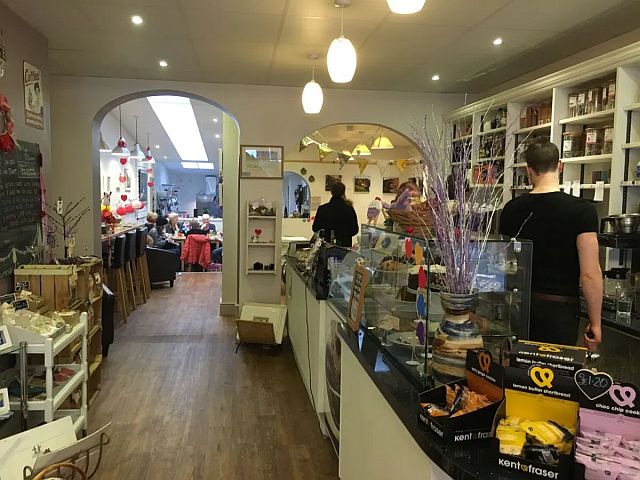
Interior of Cloudberry, Stockport Road, Marple
Cafés, unlike that other place of drink, pubs, leave little physical evidence of their existence. Many a pub building has been repurposed, e.g. Marple’s Pineapple Inn. Not surprisingly, the further we travel back in the history of transient cafés and tea rooms, the harder information is to uncover.
What and where can we learn of Marple’s lost cafés? Trade Directories, British Newspaper Archives (online), The Manchester Guardian archives (online) resource and the Marple Shoppers Guide have been used in an attempt to build up a picture of the past. Fortunately, valuable personal memories enrich their history from the 1950’s onwards; in these days of lockdown these oral memories have come via email.
A list of those cafés identified is below; followed by a section containing whatever further information has come to hand.
1930 Aubrey’s Directory: Cheshire: Marple
- Ardern Mrs, Church Lane
- Cosy Café, 255(?) Andrew Street, Compstall
- Jink’s Café, Arkwright Road
- Lower Fold Tea Rooms, Marple Bridge
- Nadin S, 66 Church Lane
- Patchett’s Marple Bridge
- Saxon Mrs. Lower Fold, Marple Bridge
- Sidebottom’s Compstall road, Romiley
- Station Café, Marple Bridge
- Thompson J & M J, Station Bridge Café
- Woodhouse Mrs, 5 Station Road
1956/57 Manchester Liverpool and District Trades Directory
- Mitchell Mrs Marple Bridge
- Riverside Café, 19 Town Street, Marple Bridge
- Saxon Mrs, Lower Fold, Marple Bridge
- The Ark Café, 5 Oldknow Road, phone Marple 1181
From other sources
Pre First World War
- Coffee Tavern, Union Rooms, Stockport Road
- Roman Lakes Tea Rooms (1893 to date)
- Webbs Tea Rooms, Flood Gate Cottage (Edwardian)
- Gem Café (????) and Gem cinema, next to the Hatters, where the Hibbert Lane extension is.
Inter-War Years
- Station Café, Marple Bridge (1930) (1950s)
- Rose Hill Café
- Glendale Restaurant (1920s 1960s)
- Longhurst Cafe, Longhurst Lane
- Armstrongs, Doodfield
Post-War Years
- Wilson’s café, 54 Market Street, phone Marple 809 (1957)
- The Café Royal, Stockport Road (1950s ? 1960s?)
- Cherry Tree Café, Market Street (?)
- Copper Kettle, Stockport Road (????)
- Gainsborough Galleries Tea Rooms - 62 Market Street (1992)
- Greenery Café – 31 Market Street (1992)
- The Olive Branch – 6 Derby Way (1992)
- Tudor Teas, 19 Stockport Road (1992)
- Hewitt’s, Stockport Road (2012 closed)
- Portabello, Market Street - closed 2020
- Something Else, Market Street (2000)
- Toast (2005 – 2012)
Memories & Further Information
Coffee Tavern
Situated in the Union Rooms on Stockport Road.
From a report in (Hyde & Glossop Weekly News, and North Cheshire Herald - Saturday 02 November 1878).
The Coffee Tavern is a splendidly fitted up apartment; it has seats, tables, etc. The bar is a very attractive structure, with coffee, cocoa, and tea stands, the liquids from which will be retailed at a penny per cup.
Coffee Taverns - not just in Marple
The Temperance Movement was at the height of its influence and membership in the 1880s. This was a society that condemned alcohol as the root of the problems of poverty and destitution. They bought up restaurants and music halls, trying to recreate the atmosphere of the coffee houses of the 16th century. Working men were encouraged to visit establishments that provided teetotal entertainment as an alternative to the many public houses which were widely blamed for causing drunkenness and ill-health amongst the working-class people.
Roman Lakes
As Victoria’s reign neared its end, the numbers of visitors [to Marple and Mellor] increased. In 1884, a newspaper reported that “Marple Station was greatly thronged on Good Friday…between two and three thousand visited the place by ordinary and special train”…… The destruction of Mellor Mill in 1892 had led to the biggest attraction.
Edwin Furness, used poetic licence to rename the old packhorse bridge across the Goyt as, the Roman Bridge. The Park prospered. People headed for the Roman Lakes to listen to a band, join the dance, row on the lake and play on the slot machines. By the end of the 1930’s, as buses and cars made it easier to go further into the countryside and cinemas provided entertainment in the towns, the popularity declined, but revived during the Second World War when cars were deprived of petrol. Bands, dancing and slot machines have gone but the present owners, the Sewarts, continue to run the Leisure Park, with an income from fishing and sale of refreshments and a welcome for walkers and cyclists. With the strong support of Bernard Sewart as chairman and Rachel as secretary, the newly formed Friends of our Valley are enhancing the opportunities to enjoy the beauty of this section of the River Goyt and its wildlife.
A resident of Hyde recalled in 1983
“the happy memories of those halcyon days before the last war, which I spent in Marple Bridge and the surrounding countryside…On Sundays, thousands of day trippers arrived in Marple all bound for the Roman Lakes where they picnicked in the nearby fields, and rowed on the Lake, and spent their pennies inn the slot machines..”
Marple Station Café
Before Midlers the building was the Station Café and had a sweets confectionery, cigarette and toy etc. shop, which we were allowed to visit and spend our bus fare on the way home from school in Marple Bridge if we chose to walk. It had a coffee bar that was a meeting place for youth.
The cab shelter at that time (1950 and 60s) was in a small wooden structure adjacent to the café on the uphill side, it wasn’t much bigger than a fair sized garden shed but did have a phone it presumably so a cab could be called if one wasn’t waiting.
Jinks Café (1920s 1930s)
Jinks was situated either on Arkwright Road or on the site of the present Forces Club.
In the Alderley & Wilmslow Advertiser - Friday 04 July 1924 Advertiser
Application for music and dancing licence was made by Jinks of Jinks Café, Marple.—Applicant said he was a boat builder but, that his particular branch of the trade was now obsolete, and it was in order make that he had established the café. The building in which the dancing would take place would be a credit to himself and to Marple. There would air dancing on a platform 50 feet square, and if the weather was unsuitable the dancers would be accommodated in the building where there would be a space of 50ft. by 20ft. Supt. Sudlow said he had been by the Chief Constable to request the magistrates to adjourn the case and to ask that a plan should be submitted so that they could see what the licence was for. The Chief Constable did not consider that a licence should be granted in respect of a wooden building. If dancing was excluded from the café there would not be be much objection to dancing platform. It was necessary to put an extra exit in the building for use in case of emergency. The licence was granted in respect of the platform, but at the Licensing Sessions on August 14th. Mr Jinks could renew his application for a licence for the café and in the meantime he must submit a plan and provide emergency exit. APPLICATIONS REFUSED.
Rose Hill Café
This may be seen in this photo, that shows the opening of the Rose Hill Co-op, on Stockport Road on 1oth October 1936. The dates of opening and closure are unknown. St the time of writing this is now the Salon, a hairdressers.
Glendale Café
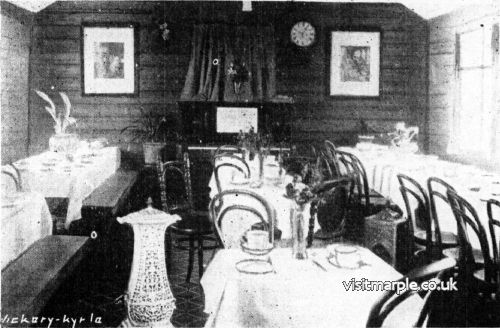 Dale Road café was on the site where nos 44. 44a. 46 Dale Road are now. This photo of its first incarnation was taken in 1927.The cafe had a destructive fire in the first week of January 1962. It held wedding receptions, funeral parties. Evening meals were held, with dancing to an organist and drummer. Large lawns lay to the rear. The cafe closed post 1972, the last owner being Gordon Pott.
Dale Road café was on the site where nos 44. 44a. 46 Dale Road are now. This photo of its first incarnation was taken in 1927.The cafe had a destructive fire in the first week of January 1962. It held wedding receptions, funeral parties. Evening meals were held, with dancing to an organist and drummer. Large lawns lay to the rear. The cafe closed post 1972, the last owner being Gordon Pott.
The location of the Dale café is shown on a 25inch OS Map of 1938, by the red circle.
Lynda & Neil Jenkins had their wedding reception at the Glendale in March 1966. click photo
In this second photo of the wedding we see the exterior of the Glendale, it shows the father of the bride, Sidney Atkinson, with Beryl Jenkins, sister of the groom.
ARK Café
The Ark Café was opposite the Recreation Ground on Oldknow Road.
Lynda Jenkins writes:
We used to go there as often as we could. It stood opposite where we played on the recreation ground. We used to buy sweets, Wall’s ice cream in a cone. The ice cream was wrapped in paper and it was oblong in shape so the cone was oblong at the top to fit it in. We also used to buy Kali, a sugary sherbet sweet.Scooped out of a jar and into a white paper bag. We used to stick our finger in the bag an ended up with a coloured finger. Happy days.
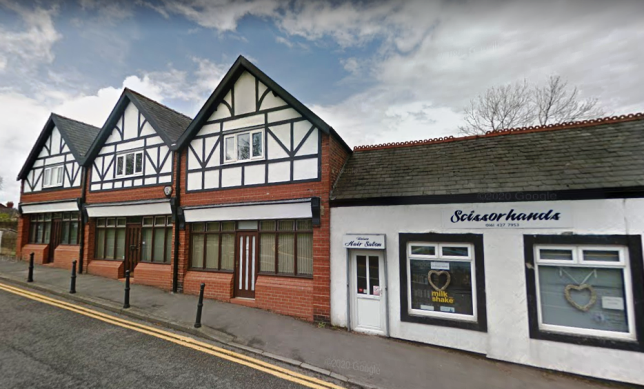
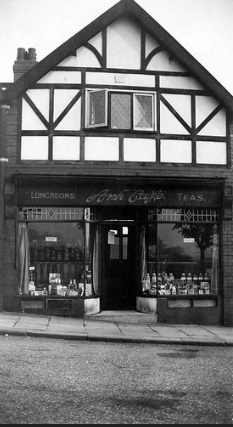
(photos of Ark café then and now)
The Café Royal
The Café Royal was on Stockport Road just below the junction with Hollins Lane and upstairs (1st. floor)
Riverside Café
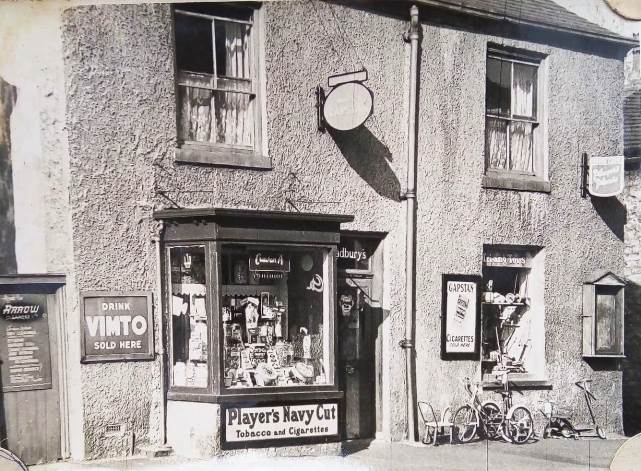
Riverside Cafe (now the Well Pharmacy) Town Street, Marple Bridge
From Catharine Brown on behalf of her mother Jean Filkins (ne Oldham)
I have spoken to mum (Jean Filkins) about cafés in MB. Yes, her mum and dad bought the Riverside café, and ran it as a café and a shop up until approx. 1958. Then they closed the café area and called it Oldham's (mum maiden name), and they started to sell prams and cots and large toys instead. As you look at the building, the café was in the right hand side, a big, long room. Marple Bridge was very popular with day-trippers coming from Manchester to the Roman Lakes, and my gran would do morning coffee, lunches and teas. It was the first time mum had seen proper brewed coffee, it would be brewed up in a big pan and strained off, and that would then be used all day and reheated when required. Also, the Catholics would come down from St Mary's for a coffee after the Sunday morning service. This photo is in the assembly room above mum's shop (the chemist). It was used by Marple Bridge Chess club, for Quaker’s meetings, dancing class, and as you can see, wedding reception/breakfasts.
Mum thinks that there might have been a café in the shops along from Ian Mann, but can't really remember any details.
Bill Beard
I do remember a number the cafés you mentioned but didn't go in many, as children we didn't really have money so we went home for drinks, food etc., however in later years at primary school (St Marys) I was allowed to spend my bus fare(1or 2d) and walk home so we often would buy penny chews, liquorice, aniseed balls, chewing gum, bubble gum etc from the Riverside café which sold many other thing like toys, ice creams, cigarettes, so really more like a shop with tearoom attached as were others such as the Station Café (lately The Purple Pakora).
Riverside Café, on Sundays there was a special bus service (North Western Buses) from Rose Hill to All Saints and St Marys churches (there were no regular buses between Rose Hill and Marple Bridge)and while waiting for the return bus with my mother, and others, in the café would sometimes be bought a hot drink (Bovril was my favourite). The bus turned round in the small car park at the bottom of Hollins Lane (near the forge).
See a flyer for the cafe by clicking "image". The café had an art exhibition in November 1946, click "press cutting"
Toast Café
Toast Café opened on Market Street, circa 2005, these premises are presently Potabello. From there they moved to Derby Way, closing in 2012. Click "Toast Deli" to see their appearence at the Marple 2010 Food Market.."Showing a range of exotic hot soups, cold soups to take away, cheeses, olives, fair trade teas and coffees."
Costa Café
Opened November 2011
Source Marple-UK Forum 2009
A posting by the late Ron Singleton, long-term landlord of the Navigation Pub
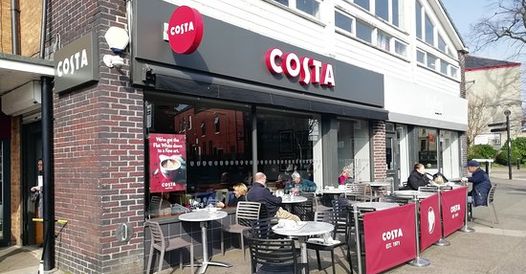 (The Hollins shops date from c.1963)
(The Hollins shops date from c.1963)
"The supermarket on the Hollins was the first building to be occupied on the parade by John Williams, the multiple grocers in the Stockport/Cheshire area. John Williams had two shops in Marple, one on Market Street between Whites Butchers (which was then Rodgers Butchers) and Astleys Newsagents. The other shop was where Dolce Vita Restaurant is now. They moved across the road when the new supermarket was built, it had a café upstairs when first opened but that soon closed down because all the local youths were using it, buying a cup of tea and spend all day using it as a youth club. Those same youths will be grandparents now.
A forever changing café scene
Through the 130 year history of Marple & Mellor’s café and tea rooms fashion and enterprises may have changed greatly, but they still fulfil that human need to relax and chat. Now they probably outnumber the pubs of the area. Something to ponder over as the turkey is carved. You may also ask just how much of today’s café culture is driven by the power of the silver pound.
Should this article have stirred any long mislaid memories of the cafes in Marple & area, feel free to contact
Martin Cruickshank, December 2020
With sincere thanks to Bill Beard, Hilary Atkinson, Lynda Jenkins and Neil Mullineux for their valuable assitance. - Any inaccuracies are purely my invention.
Further reading, further afield:
- To take yourself back to the 1930s station cafe: "Brief Encounter Cafe"
- Read of the "Rise & Fall of Lyons Cornerhouses"
- How a British teashop helped create the first office computer
- Lost Manchester: The Kardomah
- Newspapers, gossip and coffee-house culture
- Café nation? Exploring the growth of the UK café industry

